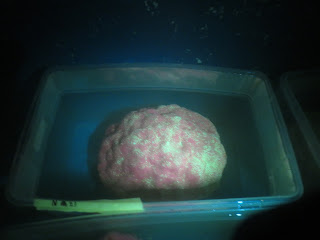Spawn Watch 2022
 |
| One of our coral parents sitting in its tank during the nightly spawn watch. This photo was taken using a blue light and a yellow filter, so you can see the red and green fluorescence. |
This is our second full moon in Palau. Last month, a few individuals of our study species spawned, and we got enough larvae for one experiment. We didn't have enough individuals for our full transplant experiment, so this month, we're hoping for more.
We collected all our parent corals from our study sites and set them up in seawater tanks at PICRC. Every evening, we isolate them in small tanks to keep the eggs and sperm separate if they do spawn, then check them every half hour between 7 and 11 pm. We call this part of the day Spawn Watch. It usually involves Cas, Matt, and me sitting in the wet lab for four hours, quietly working on our own computers. One of us gets up at the top and bottom of the hour to check our colonies. So far, nobody has spawned.
That's ok. The full moon was only yesterday, and last month, the spawn came 3 days after the full moon. We're probably in for a few more boring evenings.
 |
| Cas showing some preliminary results from our heat stress experiment to the discussion group |
Things are relatively calm at the station right now. I really hope we get more spawning!
Comments
Post a Comment